Out of the eight planets in our Solar System, only two, namely Mercury and Venus, are without moons. Our Earth has only one Moon, while Mars has two, but Saturn is the King of the Moons.
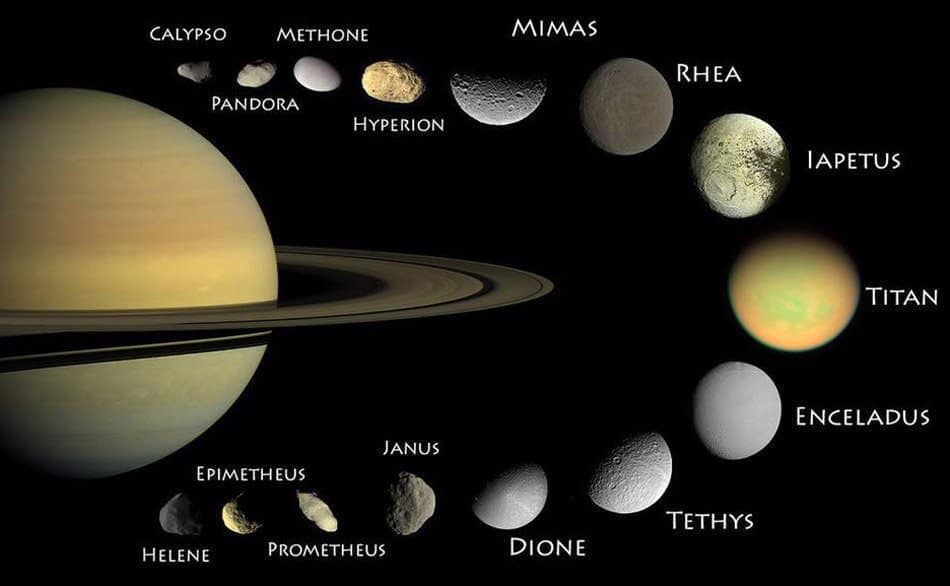
How many moons does Saturn have? A total of 82 confirmed moons, surpassing even Jupiter, which has 79. There could be even more hidden moons that orbit around Saturn, and as such, this gas giant will be from now on not only recognized for its prominent rings but also its numerous moons.
The Moons of Saturn
Some of the moons of Saturn are among the biggest in the Solar System, like Titan, for example, which is bigger than even the planet Mercury. Others are smaller than our Moon; however, they have unique characteristics. As such, let us examine the top five biggest moons of Saturn, namely Titan, Rhea, Iapetus, Dione, and Tethys.
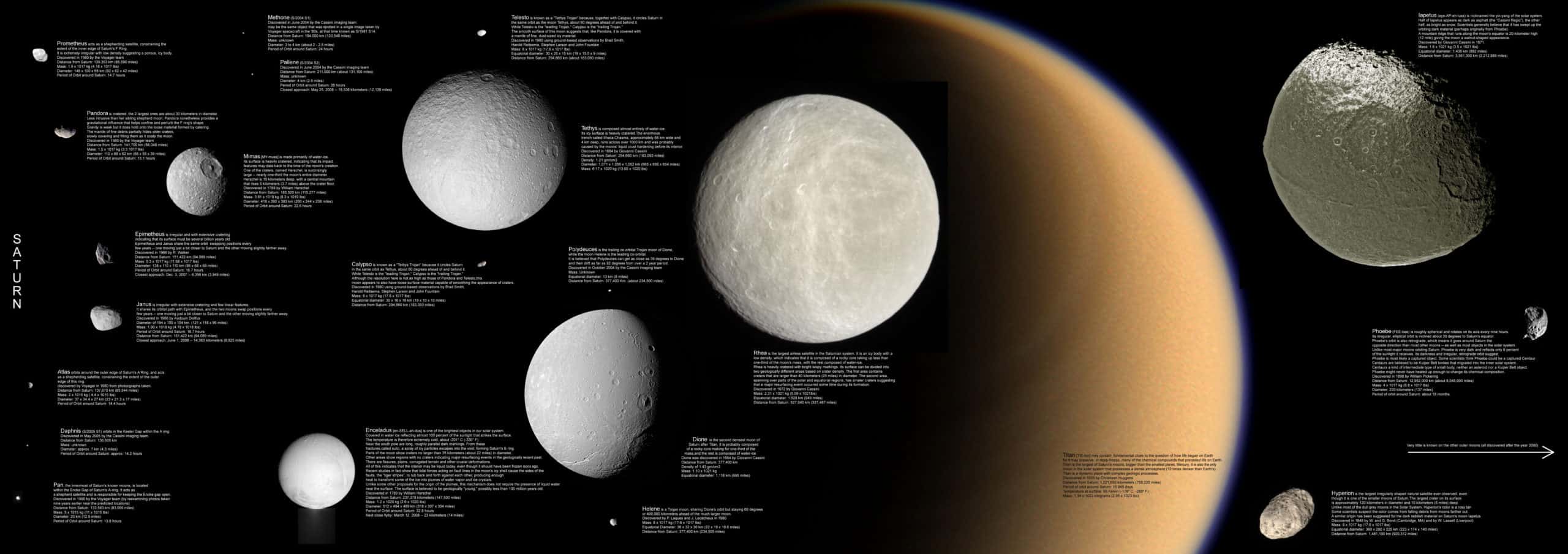
Titan
Apart from being the second-largest moon in the Solar System, and the largest moon of Saturn, Titan is the only celestial object besides our planet, where stable bodies of surface liquid have been found.
Titan is 50% larger in diameter than the planet Mercury, having a diameter of 5,149 km / 3,199 mi, and a radius of 2,574 km / 1,599 mi. Titan is the sixth gravitationally rounded moon of Saturn, and it is commonly described as a planet-like moon.

This giant moon was discovered in early 1655 by the Dutch astronomer Christiaan Huygens, being the first recorded moon of Saturn.
Titan is mostly made out of ice and rocky material, and it is the only moon currently known to have a dense atmosphere. This thick atmosphere is similar to that of Venus. It is mostly made out of nitrogen, while the climate is similar to Earth, as it has winds and rain which create similar surface features such as dunes, rivers, lakes, seas, and deltas. Most of the liquid bodies are made out of liquid methane and ethane. The temperatures on Titan are around 93.7 K / -179.5oC.

Rhea
Rhea is the second-largest moon of Saturn after Titan, and overall the ninth-largest moon in the Solar System. It is bigger than the dwarf planets Makemake and Ceres.
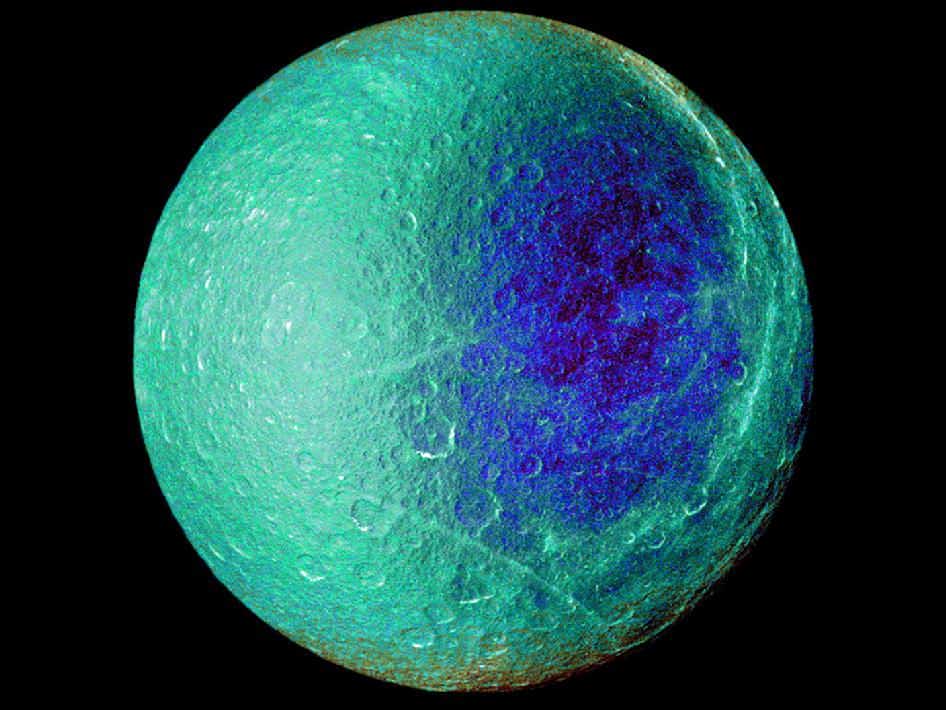
Rhea has a diameter of around 1,527 km / 948 mi and a radius of 763 km / 474 mi. It is more than two times smaller than our Moon. Rhea is also considered the second-smallest celestial object in the Solar System for which precise measurements have confirmed a shape consistent with hydrostatic equilibrium, after the dwarf planet Ceres.
This moon was discovered in 1672 by the Italian astronomer Giovanni Domenico Cassini. The lowest temperatures on this moon were recorded at 53 K, while the highest at 99 K.
Rhea is an icy body being made of around 25% rock and 75% water ice. Some believe that this moon doesn’t have a core beneath its surface, implying a homogenous interior.
Iapetus
Iapetus is the third largest moon of Saturn and the eleventh-largest moon in the Solar System. It is bigger than the dwarf planets Makemake and Ceres.
Iapetus has a diameter of 1,469 km / 912 mi, and a radius of 734 km / 456 mi. This moon was discovered in 1671 by Italian astronomer G.D. Cassini. The moon is quite easily recognizable due to its unusual two-toned surface.
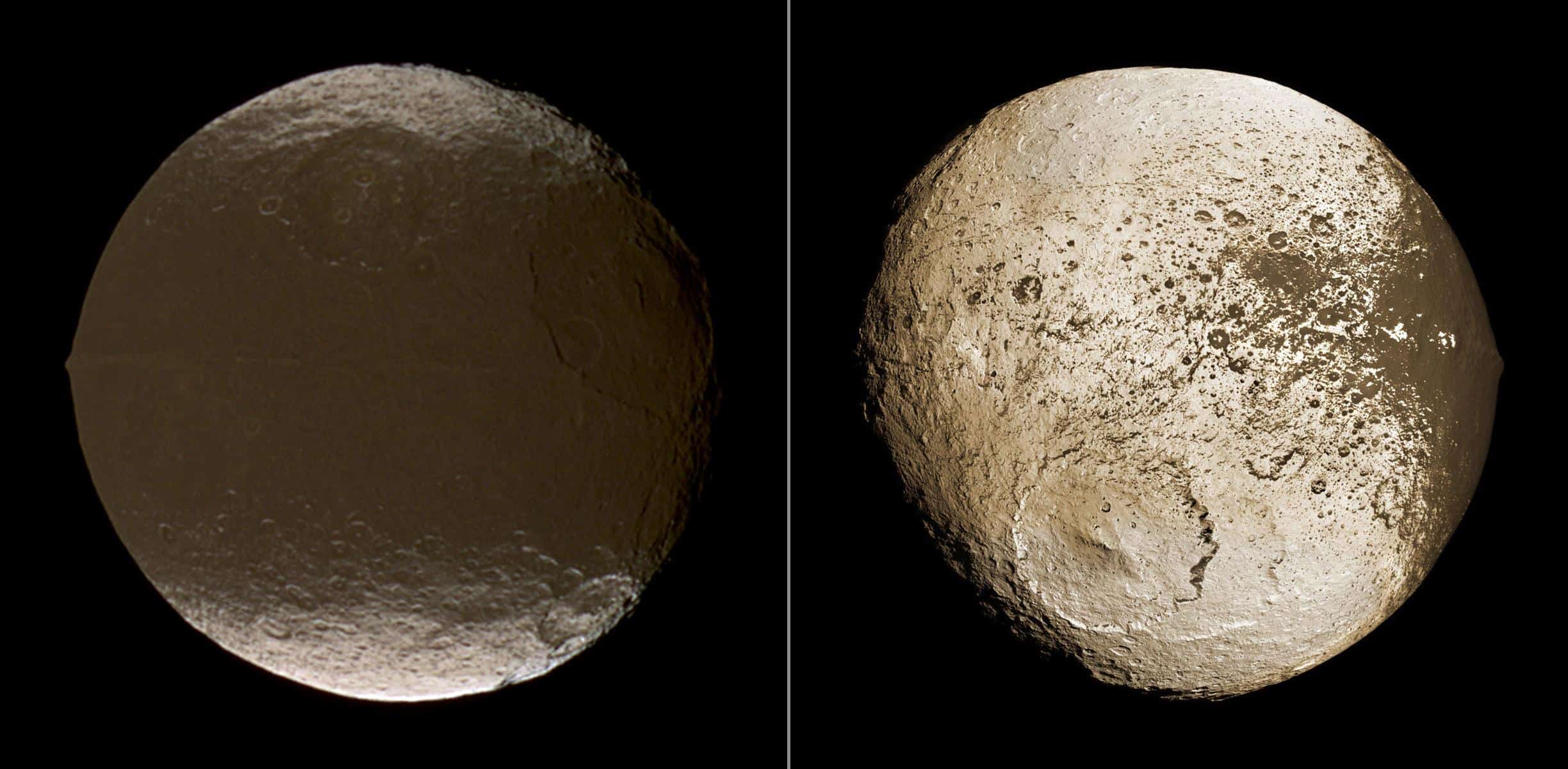
It is among the most distant moon’s which orbit Saturn, and it has the largest orbital inclination of 15.47o. Iapetus is also known as the ying-yang of the Solar System due to its appearance.
Iapetus has a low density, and thus it is speculated that it is mostly made out of rocky materials and ice. It has a bulging waistline and squashed poles. The equatorial ridge runs along the center of Cassini Regio, and it is approximately 1,300 km / 810 mi long, 20 km / 12 mi wide, and 13 km / 8.1 mi high.
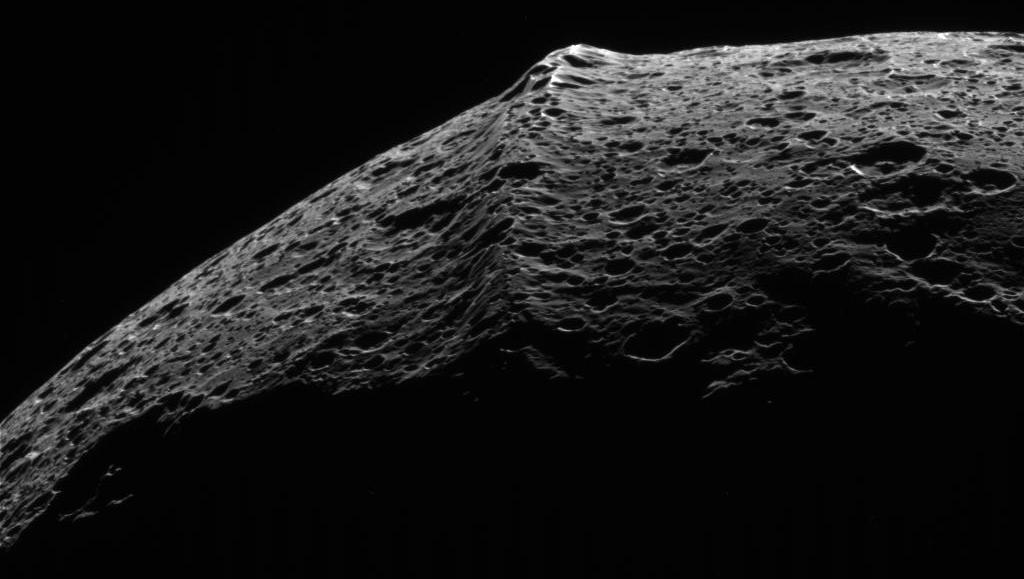
The reasons for why Iapetus has such a ridge or chaotic orbit are not fully understood, yet many theorize that the satellite suffered a collision in its past. Astronomers believe that Iapetus’s two-toned coloration is attributed to Phoebe, a smaller moon of Saturn. Phoeve is dark and emits streams of particles that accumulate on one side of Iapetus, while the other side remains white due to temperature differences.
Dione
Dione is one of the largest inner moons of Saturn, and it was discovered in 1684 by Italian astronomer G.D. Cassini. Dione is the fifteenth largest moon in the Solar System, and it has a diameter of around 1,122 km / 697 mi and a radius of 561 km / 348 mi.
Despite being the fifteenth largest moon in the Solar System, Dione is more massive (weight) than all the other smaller moons combined. Dione’s mass is two-thirds water ice, and the remaining is attributed to a silicate rock inner core. Some data suggests that Dione might have an internal liquid saltwater ocean, similar to Enceladus.
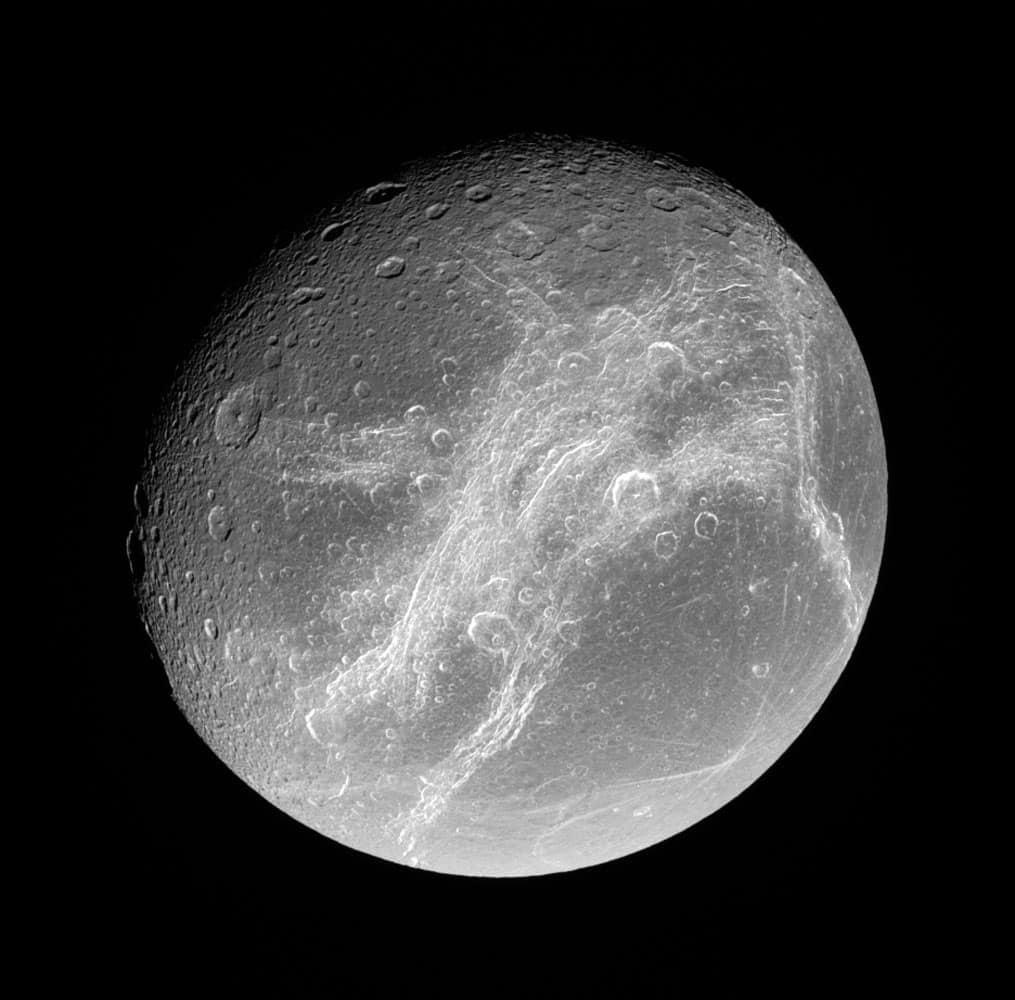
Dione might be geologically active, and some of its surface features prove that this moon was active in the past. Dione is bigger than the dwarf planet, which is also classified as an asteroid, Ceres.
Tethys
Tethys is another moon discovered by G.D. Cassini in 1684. It has the lowest density of all the major moons in the Solar System. Tethys is bigger than the dwarf planet Ceres, having a diameter of 1,062 km / 659 mi, and a radius of 531 km / 329 mi.
Tethys is mostly made out of water ice and a very small fraction of rock. A small amount of an unidentified dark material is also present on its surface.
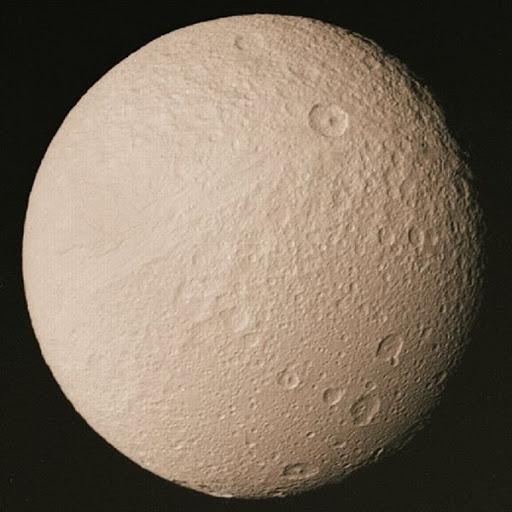
Thetys has a heavily cratered surface, with the largest impact crater, named Odysseus, having a diameter of around 400 km / 248 mi, and the biggest graben, known as Ithaca Chasma, is about 100 km / 62 mi wide, and 2,000 km / 1,242 mi long.
Tethys has been visited by multiple spacecraft, such as Pioneer 11, in 1979, Voyager 1, in 1980, Voyager 2, in 1981, and numerous times by the Cassini space probe between 2004 and 2017. Tethys is the sixteenth largest moon in the Solar System.
Did you know?
- The Saturnian moon Rhea has an exosphere which consists mainly out of oxygen and carbon dioxide.
- If you want to hear something eerie, check out the radio emissions of Saturn on the internet.
- The rings of Saturn are its most prominent feature, yet Saturn will lose its rings in about 100 million years. This is because Saturn’s gravity pulls the ring systems within, and its strong magnetic field bombards them.
- We often hear tales of the Great Flood that destroyed many human civilizations. Some believe that this apocalyptic event was produced by Saturn. A theory suggests that both Saturn and Jupiter got close to each other in one point in time, and thus provoked the Great Flood on Earth.
- Saturn is quite bright in the sky, and many ancient civilizations often considered it a star rather than a planet. Many also mistook it for the Sun itself.
- Saturn is prominently featured in many tales of old. Even the day Saturday is named after this planet.
- Titan, the largest moon of Saturn, comprises more than 96% of the mass in orbit which surrounds the ringed planet.
- Enceladus is another prominent moon of Saturn. It has over 100 geysers near its south pole.
- It is suspected that Saturn might have a total of 150 moons, yet only 82 of them are named and officially recognized since 2020.
Sources:
Image Sources:
- https://i2.wp.com/www.astronomylovers.com/wp-content/uploads/2019/02/DfA-MVwU0AEMFlm.jpg?fit=950%2C586&ssl=1
- https://upload.wikimedia.org/wikipedia/commons/thumb/4/4b/Moons_of_Saturn_2007.jpg/1280px-Moons_of_Saturn_2007.jpg
- https://images.theconversation.com/files/179969/original/file-20170727-8497-16uhpy3.jpg?ixlib=rb-1.1.0&q=45&auto=format&w=496&fit=clip
- https://i.insider.com/5d767b2e2e22af718b0acf37?width=1100&format=jpeg&auto=webp
- https://www.universetoday.com/wp-content/uploads/2010/12/Rhea-1.jpg
- https://solarsystem.nasa.gov/system/content_pages/main_images/805_PIA12648.jpg
- https://solarsystem.nasa.gov/system/content_pages/main_images/932_PIA11690.jpg
- https://solarsystem.nasa.gov/system/content_pages/main_images/932_PIA11690.jpg
- https://cdn.britannica.com/74/145074-050-4D9110AA/Dione-image-moons-Saturn-spacecraft-Cassini-July-24-2006.jpg
- https://lh3.googleusercontent.com/proxy/43UuVH7-4Qq_Z8t9amXuPEzCZCq0zFf9twRdNZv6MMo5s2vqdafU4AR5tf7Fd67-JAvFQ2GviPOyBw0T0ddhNwkQ5hJvqpYoXldwmycgfiWbWcAG2qsp

